#H2 media
Explore tagged Tumblr posts
Text






Traditional Palestinian tatreez embroidered pillowcases (and a scarf). Picked up in beautiful Hebron in the old city.
#tatreez#embroidery#Palestine#free palestine#I just got back from three weeks in the West Bank#met so many remarkable people#the sumud is so humbling#the occupation is so intense to see in real life#I think it’s possible to understand it from the news and social media#but to turn a corner and see the apartheid wall#to go through the markets and see the state of the local economy#to be forced to walk 2km bc the road is for israelis only and your home and your work are on opposite sides of it#to talk to people in H2 who have watched their children and their neighbors children beaten regularly#well#palestine will be free#and I highly recommend visiting the West Bank either as a tourist or to do protective presence#be there!! see!! connect w people!!
2 notes
·
View notes
Text
#134.1 - JACK&JOZEF - Autorijden op waterstof
#auto#car#benzine#H2#CO2#transitie#mobile#experiment#omdenken#gesprek#tv#radio#JackJozef#media#podcast#vodcast#RTL#SBS6#TalpaNetwork#LifeSoap#PodcastGemist#ForYou#Juice#Juke#nrc#GoodVibes#DutchMediaWeek#podcastgemist#jackjozef#youtube
2 notes
·
View notes
Text
Denver SEO Company: SEO Tips you Need to Know!!!!
Denver SEO Company: SEO Tips you Need to Know!!!
Each page on the SEO Expert in Denverwebsite must be optimized with a focus on On-Page SEO. This includes:
Titles and Meta Descriptions:
Ensure each page has catchy, descriptive titles with the right keywords. Use meta descriptions that invite users to click on results.
Headings (H1, H2, H3): Use heading tags to structure the content and make it easier to read. This also helps Google better understand the theme of the page.
Optimized Images:
All images must have ALT attributes with appropriate descriptions and must be compressed to improve loading. Practical Tips: Use main keywords in the title and URL. Insert internal links to guide the user to other relevant pages on the site. Create friendly, short and descriptive URLs.
Creating Quality Backlinks:
Backlinks, or links from other websites that point to yours, are a determining factor in Google rankings. Earn quality backlinks by:
Publish guest posts on relevant blogs:
Create partnerships with other companies and ask for links to the SEO Expert in Denver website. http://denverseo.company/ Publish case studies and financial reports that other companies may want to reference.
Practical Tips:
Build links on authority sites like media outlets and finance blogs. Avoid link building techniques that are considered spam, as Google may penalize the site. Have a digital Public Relations strategy, sending press releases.
Local SEO: Capture Customers in the Region:
SEO Expert in Denver can significantly benefit from local SEO, especially to attract customers in the Northeast region. For that:
Optimize your listing on Google My Business. Enter information about SEO Expert in Denver's location on the website. Encourage your customers to leave reviews online. Practical Tips: Include location in keywords, such as “Financial consultancy in Recife”. Use Google My Business to highlight events and related posts.
Video Content:
Video content is a powerful tool for SEO as it increases dwell time on the website. SEO Expert in Denver can create explanatory videos, interviews with experts and customer testimonials, covering topics such as “How to get credit for my company” or “The role of consultancy in fundraising”.
Practical Tips:
Publish videos to YouTube with optimized descriptions and website links. Integrate videos on the main pages of the SEO Expert in Denver website to increase engagement.
Off-Page SEO: Increasing Brand Presence:
In addition to backlinks, it is important to increase SEO Expert in Denver’s presence on other platforms and social media. Have a well-defined content strategy for LinkedIn, Instagram and Facebook, where you can share financial insights, promotions and educational materials.
Continuous Analysis and Adjustments:
SEO is a strategy that requires continuous analysis. Use tools like Google Analytics to track traffic and understand user behavior on your website. Adjust the strategy as necessary, always seeking to improve rankings and attract more qualified leads.
Practical Tips:
Monitor top-performing pages and update old content. Test different keywords and content strategies to see what generates the most leads.
Pillar Content Creation:
Create pillar content, which covers broad topics such as “Fundraising for Companies”, linking to more specific content (content clusters). This creates a hierarchical content structure that makes it easier for users to navigate and improves SEO. https://denverseo.company/about/
Conclusion:
To attract more qualified leads and improve SEO Expert in Denver website authority, it is crucial to implement a thorough SEO strategy. From technical optimization to creating valuable content and quality back links, each action contributes to organic growth. With these practices, SEO Expert in Denver can stand out as a reference in the financial consultancy and fundraising sector
25 notes
·
View notes
Text
Basics of HTML5: Let's build a webpage!
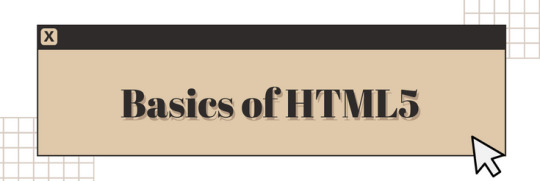
I'm a huge advocate for learning HTML5 as your first coding language (remember, it's not a programming language)! HTML5 is a great and easy coding language to get you into the feel of coding, especially for complete complete beginners!
I see a lot of people on Tumblr wanting to get into just creating their own websites but don't know how to start - coding is a new thing to them! So, I'm here to help with the language I know like it's the back of my hand!
And I am also an advocate of building projects in order to learn anything in coding/programming! Thus, what better way to learn the basics of HTML5 than to actually build a simple webpage? Let's get started~!

What is HTML5?
HTML, which stands for Hypertext Markup Language, is a special coding language that is used to create webpages. With HTML, you can tell a web browser, like Google Chrome or Safari, what to display on a webpage, such as text, images, and videos. And 'HTML5' is just the latest version of HTML!
HTML tags are special words or symbols that you use to create webpages. You use these tags to tell the web browser what content to display on a webpage, like headings, paragraphs, images, links, and more. Tags come in pairs (most of the time) so you'll have an opening tag and a closing tag. An example of the syntax:


The Simple Webpage
As I mentioned, we will be making a simple webpage for a person called David - see, he needs a portfolio webpage to start off with, and we're going to help me (as well as learning HTML5, of course).
Here is the code we will be using:
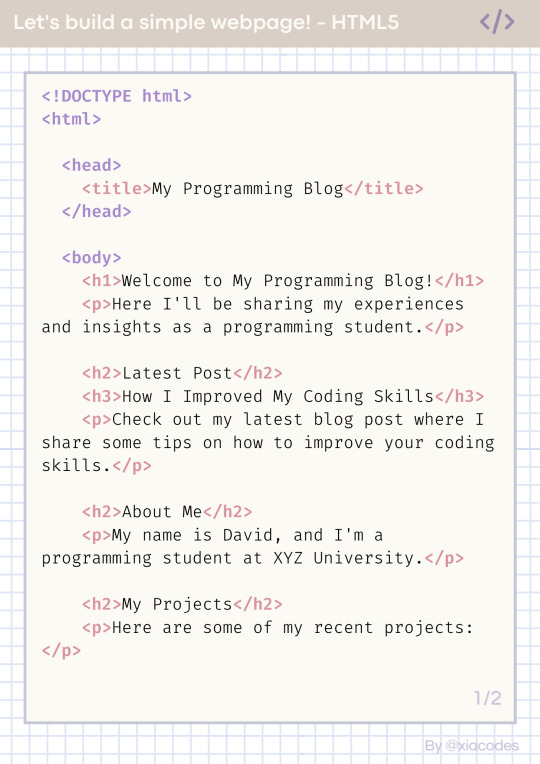
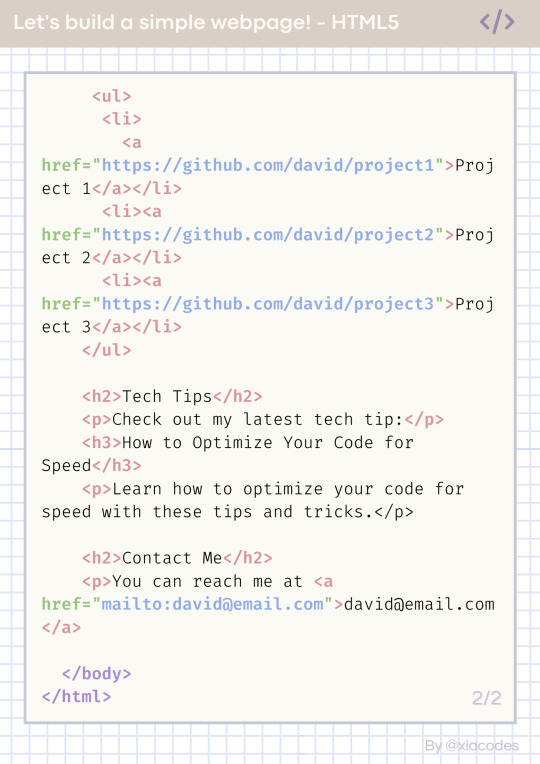
Pretty code, I know but also a bit confusing - let's get into understanding the code by grouping them into chunks! But just a heads up, the code includes these tags:
!DOCTYPE html (mmh it's more of a declaration really)
html, head, body
title
h1, h2, h3
p, a
li, ul, ol
These are some of the common tags used in all webpages on the internet! Okay, let's look at the code finally~!

The basic structure of every HTML page
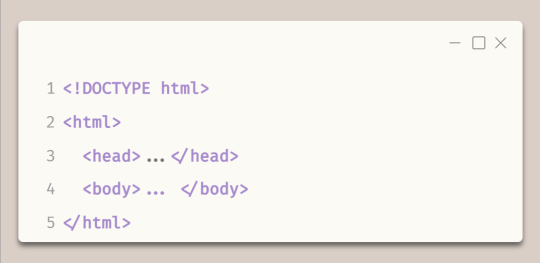
Every HTML file looks like this - it has to have all of these tags!
The first line, !DOCTYPE html tag, tells the web browser which version of HTML is being used.
The code is contained within html tags, which enclose the entire webpage.
The head tags contain information about the webpage, such as the title and links to other resources.
The body tags contain the main and visible content of the webpage, such as text, images, and videos.
Together, this code provides the basic structure for an HTML webpage, with the head tags containing metadata and the body tags containing the actual content.
In the head tags
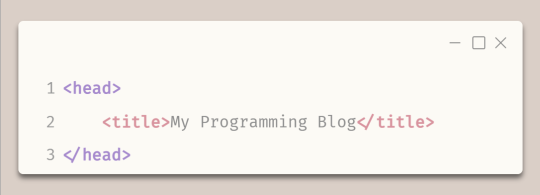
The title tags enclose the title of the webpage. In this example, the title is "My Programming Blog".
The title appears in the title bar of the web browser and is often used by search engines and social media sites to display the name of the webpage.
In the body tags - Headings and paragraphs
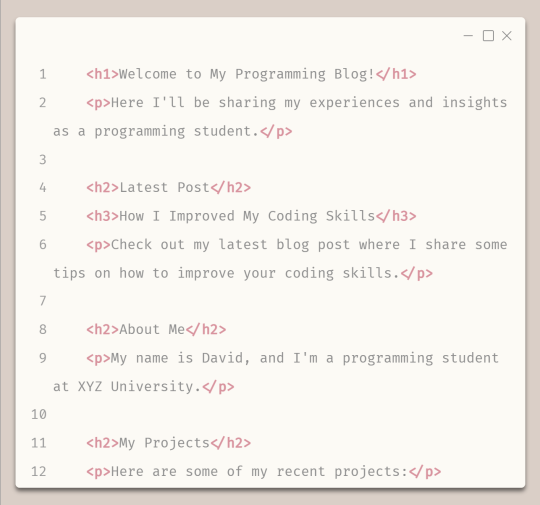
The h1 tags create a main and biggest heading, which in this case is "Welcome to My Programming Blog!" - you can only have one h1 tag on a webpage.
The h2 tags create subheadings, which in this case include "Latest Post", "About Me", and "My Projects" - you can have multiple h2 to h6 tags on a page.
The h3 tags create a sub-subheading under h2 tags, which in this case is "How I Improved My Coding Skills".
The p tags create paragraphs of text that provide more detail about the blog's content and purpose, including a summary of the latest blog post and information about the author and their projects.
In the body tags - lists and links
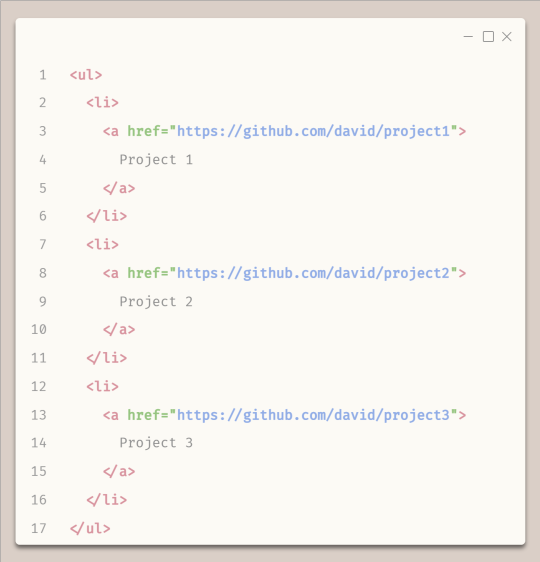
To start any list, you need to either start with ul tags or ol (ordered (numbered)) tags
The ul tags create an unordered list of items.
The li tags create list items within the unordered list.
Each list item includes a hyperlink created using the 'a' tags, with the text of the link being the name of a programming project.
The href attribute within each 'a' tag specifies the URL where the project code can be found on GitHub.
Attributes go inside the opening tags' arrows '<' and '>'.

The End Result
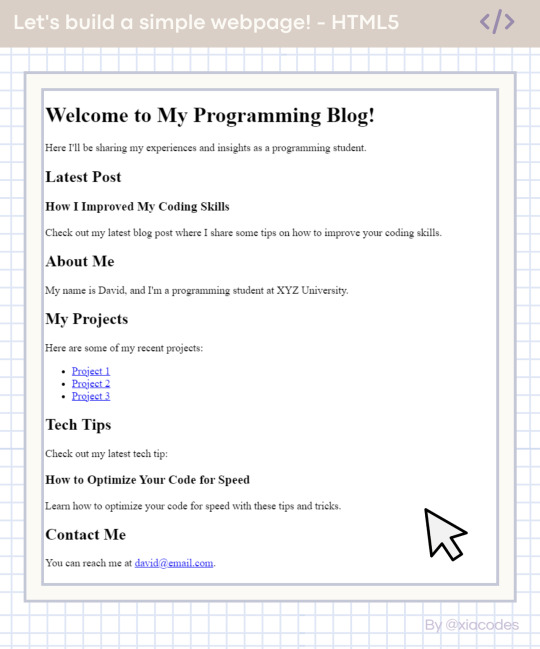
Boom - she's gorgeous, I know! A basic, simple webpage! We did it! You can see the page live + the code used here: [LINK]. Play around with the code, change things, experiment, break things, fix them - do what you need to learn further!
And that includes some online resources to help!
LINK 1 | LINK 2 | LINK 3
And some resources/posts I have shared about HTML
LINK 1 | LINK 2 | LINK 3
What next?
Learn CSS3! The page looks basic and looks like what pages were like when the internet was invented! You need colour, fancy fonts and layouts! CSS helps with that, as it is a styling sheet! Be sure to do some research but I also share resources on my blog under my #resources tag!

Thank you for reading and best of luck learning coding/programming! Remember, this isn't the only way to get into coding! People even recommend languages like Python to be beginners' first language, but I say that HTML5 should be the first coding language and then Python is your first programming language - don't know the difference? I made a post about it here!!
But definitely for people going into Web Development, HTML5 all the way! I don't think you can avoid learning HTML5 with Web Development (not 100% sure though...)!
Anyhoo, have a nice day/night! 👋🏾💻💕
#xc: programming blog post#my resources#codeblr#progblr#studyblr#resources#coding#programming#computer science#comp sci#technology#tech#software developer#programmer#coding resources#studyblr community#code newbie#learn to code
352 notes
·
View notes
Note
What media would u tell someone to get into, if you knew they'd absolutely put the time and effort into reading / watching / listening to all of it?
HYLICS its not for everyone and the vague story and lore might put off many but i absolutely love everything this series has to offer so far. if anyone is looking for a very abstract rpg which heavily relies on handmade clay animation and some of the most interesting character designs ive ever seen i cannot recommend it enough
the first game is pretty short [like 2 hours if you know what youre doing] and if you like the absurd nature of it you will love the second game with its upgraded visuals and animations and music and aaahh so beautiful . and theres also the additional musical pieces expanding the lore such as the theme songs for all the team members ['moonage lobotomy' album] and the post hylics 2 [from what i understand? unless its kinda during h2 and after? correct me if im wrong] story driven album ['absent moon']. also it made it canon that the protagonist's voice is vinny from vinesauce which broke the fandom for like a week
i know mason lindroth is working on a new game [currently known to fans as just 'new hylics' since we arent sure if its a third game in the series or a prequel or a remake of the first game because he redesigned many enemies from h1 for it so idk] and while i understand it will take a long time to create i hope it will come out while im still interested in this series and that it will be as good as hylics 2 or maybe better. whatever you do remember to be respectful to him as a creator this guy is putting out some of the most original game content possible in the current day era
30 notes
·
View notes
Text
how shinigami eyes works
first - the short version:
shinigami eyes is a browser extension that uses a fancy list called a bloom filter to identify people who can be considered transphobic or trans-supportive. a bloom filter is a kind of list that lets you check if someone is in the list, without being able to actually know the contents of the list. i go below into how it works, but the short version is Math™️, with a side effect of having false positives - thinking an item is in the list when it really isn't. whenever a social media username is detected (the exact method how depends on the website), it checks the username against that list, and applies some CSS to change the color of the text depending on what list the username is in.
the long version
shinigami eyes can be split into a few parts:
bloom filters
submissions
name highlighting
bloom filters
i'll start with the most complex part - bloom filters. the most common misconception about Shinigami Eyes is this: the filters are not updated in real-time. they are shipped with the extension which had last been updated since november 2022, according to the FF extension site. in other words: nothing marked since then can be seen by anyone other than who marked it. you can see that in the code here, where it loads the bloom filters from a data/[something].dat file included in the extension (but not in the github repo).
the following information about bloom filters is my summarized version of this page.
bloom filters are, in a slightly longer explanation than before, a way to know if an item is *not* in a list with 100% certainty, but there's a false positive rate that grows as more names are added to the list. a bloom filter of a single size is able to handle any number of items in the list, though. there's also the issue that you can't *delete* stuff from a bloom filter - you would need to regenerate it from scratch to do that.
now that the medum-sized explanation of what they are is done, let's go into how they work. a bloom filter is a set of n bits, initially all set to zero. to add items into the filter, you need a few hash functions, in this example i'll use h1, h2, and h3, with n=10. if I wanted to add the text asyncmeow to the list, i would do this: h1("asyncmeow") % n // n = 10, h1(...) % 10 = 9 h2("asyncmeow") % n // n = 10, h2(...) % 10 = 5 h3("asyncmeow") % n // n = 10, h3(...) % 10 = 8
after that, i have a list that looks like this (keep in mind that the list is zero-indexed):
[0, 0, 0, 0, 0, 1, 0, 0, 1, 1]
you can then check if something is in the filter by running the same hashing functions and checking if the result bits are set in the filter. you can access the bloom filters used for shinigami eyes by going to about:debugging#/runtime/this-firefox in Firefox and clicking "Inspect" on Shinigami Eyes, then running bloomFilters in the console. as this could possibly change in an update, i don't want to go into how they are set up, and i haven't dug enough into how their bloom filter code works well enough to say anyways.
submissions
submissions on shinigami eyes are encrypted (as in - encryption separate from HTTPS), then posted to https://shini-api.xyz/submit-vote. you can see the code for this here. when you right click someone to mark them, their name is stored in the local data of your browser in an overrides property.
name highlighting
name highlighting is done by checking them against the bloom filters and your local overrides. if a user is present in either bloom filter, or present in your local overrides, they are marked accordingly. not much to it from there.
that's really it, i think? feel free to ask if you have any questions! nya :3
77 notes
·
View notes
Text
What is the best way to optimize my website for search engines?
Optimizing Your Website for Search Engines:
Keyword Research and Planning
Identify relevant keywords and phrases for your content
Use tools like Google Keyword Planner, Ahrefs, or SEMrush to find keywords
Plan content around target keywords
On-Page Optimization
Title Tags: Write unique, descriptive titles for each page
Meta Descriptions: Write compelling, keyword-rich summaries for each page
Header Tags: Organize content with H1, H2, H3, etc. headers
Content Optimization:��Use keywords naturally, aim for 1-2% density
URL Structure: Use clean, descriptive URLs with target keywords
Technical Optimization
Page Speed: Ensure fast loading times (under 3 seconds)
Mobile-Friendliness: Ensure responsive design for mobile devices
SSL Encryption: Install an SSL certificate for secure browsing
XML Sitemap: Create and submit a sitemap to Google Search Console
Robots.txt: Optimize crawling and indexing with a robots.txt file
Content Creation and Marketing
High-Quality Content: Create informative, engaging, and valuable content
Content Marketing: Share content on social media, blogs, and guest posts
Internal Linking: Link to relevant pages on your website
Image Optimization: Use descriptive alt tags and file names
Link Building and Local SEO
Backlinks: Earn high-quality backlinks from authoritative sources
Local SEO: Claim and optimize Google My Business listing
NAP Consistency: Ensure consistent name, address, and phone number across web
Analytics and Tracking
Google Analytics: Install and track website analytics
Google Search Console: Monitor search engine rankings and traffic
Track Keyword Rankings: Monitor target keyword rankings

8 notes
·
View notes
Text


im curious abt mataneko-kone-magnificat / rancid the sergal from F&H2. i was always aware of sergals and their popularity in the furry fandom. i figured they were a sort of "communal" species that no one really owned. i only decided to look up their origin bc of rancid. so for anyone else who wasn't aware, sergals are a fictional species created for the vilous universe, a science-fantasy world created by mick ono and kiki-uma. sergals were also adopted by the larger furry fandom and are frequently depicted outside of the context of vilous to such an extent that many people have sergal characters but are not familiar with vilous. it's unclear to me at this point in time how mick ono and kiki-uma feel about the use of sergals in other fiction, or if they are aware of the apperance of sergals in fear & hunger. (the apperance of sergals in fear & hunger is specifically because of a youtuber named neco the sergal.) anyway, now this has me thinking: what is the vilous team's stance on sergals outside the context of the setting? are they aware of their appearance in F&H? is it considered a copyright violation, or is it kinda like a hobbit / "halfling" situation where they just bled into other media and that's... it's own unrelated thing?
#my posts#fear & hunger#vilous#also vilous looks interesting TBH i love all the spec bio shit i might check it out sometime#sergal
8 notes
·
View notes
Text
Google SEO service refers to a set of strategies and techniques aimed at improving a website's organic ranking on Google's Search Engine Results Pages (SERPs) by optimizing its content, structure, and technical aspects. These services typically include keyword research, content optimization, technical SEO, link building, and user experience enhancement.
Core Components of Google SEO
1. Keyword Research and Optimization
Keywords are the foundation of SEO. An effective keyword strategy helps you reach your target audience precisely.
Recommended Tools: Use Google Keyword Planner or SEMrush to analyze popular keywords.
Keyword Selection: Prioritize long-tail keywords with high search volume and moderate competition, such as “free trial English course in Singapore.”
2. High-Quality Content Creation
Quality content is crucial for attracting users and boosting Google rankings.
Practicality: Content should address user pain points, such as FAQs or practical guides.
Optimization Tips: Naturally integrate keywords in titles (H1), subtitles (H2-H3), and the body text while maintaining semantic flow.
3. Technical Optimization
Technical SEO forms the backbone of improving Google’s ability to crawl your site effectively.
Page Speed: Optimize your website’s loading speed using Google PageSpeed Insights.
Mobile Optimization: Ensure your site performs equally well on mobile devices and tablets as it does on desktops.
Structured Data: Use Schema Markup to help Google better understand your site’s content.
4. Link Building (Backlinks)
Backlinks are a crucial part of Google’s algorithm, and high-quality links can enhance your website’s authority.
Natural Acquisition: Attract high-quality backlinks through content marketing and media outreach.
Avoid Black Hat SEO: Avoid buying low-quality backlinks to prevent penalties from Google.
5. User Experience Optimization
User behavior data, such as click-through rates and bounce rates, directly affects website rankings.
Visual Design: Optimize navigation bars, page layouts, and CTA button placements.
Interactive Features: Improve site usability with features like quick search and form submission options.
By focusing on these elements, a well-executed Google SEO strategy can significantly enhance your website's visibility and engagement.
2 notes
·
View notes
Text
What is SEO and how does it work?
SEO stands for Search Engine Optimization. It's a set of practices aimed at improving a website's visibility in search engine results pages (SERPs). The goal is to increase the quantity and quality of organic (non-paid) traffic to a website. Here’s a breakdown of how it works:
Keyword Research: This involves identifying the words and phrases that people are using to search for information related to your site. Tools like Google Keyword Planner or Ahrefs can help you find relevant keywords with good search volume and low competition.
On-Page SEO: This focuses on optimizing individual pages on your site to rank higher. Key elements include:
Title Tags: Descriptive and keyword-rich titles for each page.
Meta Descriptions: Short summaries of page content that appear in search results.
Headings: Using proper heading tags (H1, H2, etc.) to organize content.
Content Quality: Creating high-quality, relevant content that answers users’ queries.
Internal Linking: Linking to other pages within your site to improve navigation and spread link equity.
Technical SEO: This ensures that search engines can crawl and index your site efficiently. It includes:
Site Speed: Ensuring your site loads quickly.
Mobile-Friendliness: Making sure your site is responsive and works well on mobile devices.
Sitemap: Creating and submitting a sitemap to help search engines understand the structure of your site.
Robots.txt: Directing search engines on which pages to crawl and which to ignore.
Off-Page SEO: This involves activities outside your site that impact its authority and rankings. Key elements include:
Backlinks: Getting other reputable sites to link to your content. Quality backlinks act as endorsements of your site’s credibility.
Social Signals: Engagement on social media platforms can indirectly influence rankings.
User Experience (UX): Improving the overall experience on your site, such as easy navigation, engaging content, and a clean design, helps retain visitors and reduce bounce rates.
Analytics and Monitoring: Using tools like Google Analytics and Google Search Console to track your site’s performance, monitor traffic sources, and adjust strategies based on data.
SEO is an ongoing process since search engines frequently update their algorithms. Staying current with SEO best practices and adapting to changes is crucial for maintaining and improving your site's rankings.

4 notes
·
View notes
Text
Penelitian Kata Kunci
Langkah pertama dalam strategi SEO yang sukses adalah melakukan penelitian kata kunci. Kata kunci adalah istilah atau frasa yang orang gunakan untuk mencari informasi di internet. Menggunakan alat seperti Google Keyword Planner atau Ubersuggest, Anda dapat menemukan kata kunci yang relevan dengan niche Anda dan memiliki volume pencarian yang tinggi tetapi persaingan yang rendah. Setelah Anda menemukan kata kunci yang tepat, masukkan kata kunci tersebut secara strategis ke dalam konten Anda, termasuk judul, subjudul, dan teks utama.
Optimalisasi On-Page
Optimalisasi on-page adalah langkah penting berikutnya. Ini melibatkan pengoptimalan elemen-elemen di halaman website Anda agar lebih ramah mesin pencari. Pastikan setiap halaman memiliki tag judul yang unik dan deskriptif, tag meta deskripsi yang menarik, dan URL yang bersih serta mudah dibaca. Gunakan heading tag (H1, H2, H3) untuk membagi konten menjadi bagian yang mudah dipahami. Selain itu, pastikan gambar dioptimalkan dengan menggunakan tag alt yang deskriptif dan ukuran file yang tidak terlalu besar agar halaman dapat dimuat dengan cepat.
Konten Berkualitas
Konten adalah raja dalam dunia SEO. Mesin pencari seperti Google memberikan peringkat lebih tinggi kepada website yang menyediakan konten berkualitas tinggi, informatif, dan relevan. Pastikan konten Anda orisinal, menarik, dan memberikan nilai tambah bagi pembaca. Menggunakan berbagai format konten seperti artikel, video, infografis, dan podcast dapat membantu menarik berbagai jenis audiens. Selain itu, memperbarui konten secara rutin dapat membantu menjaga relevansi dan menarik kembali pengunjung yang sudah ada.
Backlink dan Link Building
Backlink, atau tautan masuk dari website lain, merupakan faktor penting dalam algoritma peringkat mesin pencari. Mendapatkan backlink dari website yang memiliki otoritas tinggi dapat meningkatkan kredibilitas dan peringkat website Anda. Anda bisa memulai dengan guest blogging, yaitu menulis artikel untuk website lain dengan menyertakan tautan kembali ke website Anda. Selain itu, pastikan internal linking atau tautan internal di dalam website Anda terstruktur dengan baik, sehingga memudahkan navigasi bagi pengguna dan mesin pencari. Penggunaan Media Sosial
Media sosial dapat menjadi alat yang ampuh untuk meningkatkan visibilitas website Anda. Dengan membagikan konten di platform media sosial seperti Facebook, Twitter, LinkedIn, dan Instagram, Anda dapat menjangkau audiens yang lebih luas dan mengarahkan lalu lintas ke website Anda. Gunakan strategi konten yang berbeda untuk setiap platform agar lebih efektif. Interaksi dengan pengikut melalui komentar dan pesan juga dapat meningkatkan keterlibatan dan membangun komunitas yang loyal.
Meningkatkan visibilitas website Anda melalui SEO membutuhkan kombinasi dari berbagai strategi dan teknik. Dari penelitian kata kunci hingga backlink dan penggunaan media sosial, setiap elemen berkontribusi terhadap kesuksesan SEO Anda. Dengan menerapkan trik-trik SEO yang disebutkan di atas, Anda dapat meningkatkan peringkat website Anda di mesin pencari, menarik lebih banyak pengunjung, dan pada akhirnya mencapai tujuan bisnis Anda. Ingatlah bahwa SEO adalah proses berkelanjutan yang memerlukan pemantauan dan penyesuaian rutin untuk tetap relevan dan efektif.
#Backlink#Google#Kata Kunci#Konten Berkualitas#Media Sosial#Meningkatkan Visibilitas#Optimalisasi#Search Engine Optimization#SEO#Tips#tips dan trik#Tips Trik#Trik#Trik SEO#Website
3 notes
·
View notes
Text
#274.3 - JACK&JOZEF - Wordt het waterstof?
Is elektrisch een tussen fase?
#ad#nrc#vk#podcast#PodcastGemist#JackJozef#vodcast#vlog#omdenken#Waterstof#H2#elektrisch#transitie#talkshow#npo#bnnvara#vandaaginside#RTL4#vpro#sbs6#weereendag#media#nieuws#tv#max
0 notes
Text
Developing an Effective SEO Strategy: Key Considerations and Steps
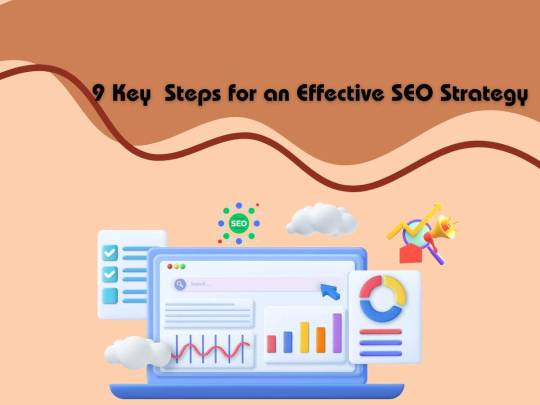
In today's competitive online marketplace, search engine optimization (SEO) is crucial for success. A well-defined SEO strategy can help increase your brand visibility, drive organic traffic to your website, and ultimately boost your bottom line. But, where do you start? In this blog, we'll explore some key considerations and steps to help you craft a robust SEO strategy and outshine your competition.
1. Set Clear Goals for SEO Strategy
Before diving into your SEO strategy, it is essential to define your goals. These goals should be measurable, achievable, and aligned with your overall business objectives. Some common objectives might include enhancing brand awareness, increasing organic traffic, improving conversion rates, or ranking higher for target keywords.
2. Conduct Keyword Research
Keywords form the foundation of any SEO strategy. Therefore, conducting thorough keyword research is paramount. Identify relevant head keywords and long-tail keywords, focusing on user intent, search volume, and competition level. Utilize tools like Google Keyword Planner, SEMrush, or Ahrefs to assist with your research.
3. Analyze Your Competitors
Understanding your competitors' strengths and weaknesses is crucial in developing an effective SEO strategy. Analyze their content, backlinks, keyword usage, and site structure, among other factors. Leverage this information to identify gaps and opportunities for your business.
4. Optimize Your On-Page SEO
Once you have your target keywords, it's time to optimize your website's on-page elements, including:
Title tags Meta descriptions Heading tags (H1, H2, H3, etc.) URL structure Image alt text Internal and external links
Ensure your content is well-written, engaging, and optimized for your target keywords without keyword stuffing.
5. Enhance Technical SEO Strategy
Technical SEO involves optimizing your website's elements that influence search engines' crawling, indexing, and ranking. Key aspects of technical SEO to focus on include:
Site speed Mobile-friendliness Website structure and navigation XML sitemaps HTTPS encryption Canonical tags Error pages (e.g., 404 pages)
6. Develop a Content Marketing SEO Strategy
Content plays a significant role in your SEO strategy. Create high-quality, valuable, and shareable content that engages your users and answers their queries. Incorporate your target keywords naturally while maintaining readability. Regularly update and optimize your content based on performance data and audience requirements.
7. Strengthen Off-Page Strategy with Link Building
Quality backlinks boost your website's authority and search engine ranking. Develop a link-building strategy that involves:
* Creating shareable, link-worthy content * Guest blogging on reputable websites * Reaching out to influencers and industry experts * Engaging in niche-specific forums * Utilizing social media platforms
8. Monitor and Measure Performance
Use tools such as Google Analytics, Google Search Console, or other paid analytics tools to track key performance indicators (KPIs) such as organic traffic, bounce rate, conversion rate, and search engine rankings. Analyzing performance data frequently will help you make informed adjustments to your SEO strategy.
9. Adapt and Adjust
SEO is a continuous process with ever-changing trends and search engine algorithms. Stay up-to-date on the latest developments and consistently assess your strategy to make necessary adjustments. Being proactive and adaptable will ensure your SEO efforts are aligned with industry standards.
In summary, developing an effective SEO strategy requires clear goals, extensive research, optimization of on-page and off-page factors, high-quality content, technical prowess, and consistent monitoring and adjustment. By following these steps and staying committed to the process, you'll be well on your way to elevating your online presence and achieving your business goals.
#BrandAwareness#EngageYourAudience#SocialStrategy#SEO#SearchEngineOptimization#KeywordResearch#OnPageSEO#LinkBuilding
9 notes
·
View notes
Text
Essential Elements of On-page SEO

On-page SEO is a critical aspect of optimizing web pages to enhance their search engine visibility and improve rankings. These optimizations involve various elements that contribute to both user experience and search engine understanding of your content. Here are the essential elements of on-page SEO:
High-Quality Content: The cornerstone of on-page SEO is high-quality, relevant content. Create content that addresses the needs and queries of your target audience. Well-written, informative content not only engages visitors but also signals to search engines that your page is valuable.
Keyword Optimization: Incorporate relevant keywords naturally into your content. Focus on the primary keyword for the page in strategic locations such as the title tag, headings, meta description, and throughout the body of the content. Avoid keyword stuffing, and aim for a natural and coherent flow.
Title Tags: Craft compelling and descriptive title tags for your pages. The title tag is a crucial on-page SEO element and is often used as the main headline in search engine results. Include the primary keyword and make the title tag enticing to encourage click-throughs.
Meta Descriptions: Write concise and informative meta-descriptions that provide a brief overview of the page's content. While meta descriptions may not directly impact rankings, they influence click-through rates, making them important for attracting users from search engine results pages.
Header Tags (H1, H2, H3, etc.): Use header tags to structure your content. The H1 tag represents the main heading and should include the primary keyword. Subheadings (H2, H3, etc.) break down the content into sections, improving readability and helping search engines understand the hierarchy of information.
URL Structure: Create clean and descriptive URLs that reflect the content of the page. Avoid generic URLs with strings of numbers or symbols. Include relevant keywords and maintain a clear structure for both users and search engines.
Image Optimization: Optimize images by using descriptive file names and adding alt text. Alt text provides a textual description of an image, aiding accessibility and allowing search engines to understand the content. Compress images to improve page load times.
Internal Linking: Incorporate internal links within your content to connect related pages on your website. Internal linking helps distribute page authority, enhances navigation, and encourages users to explore more of your content.
External Linking: Include authoritative external links to reputable sources when relevant. Outbound links provide additional context to your content and contribute to your page's credibility in the eyes of search engines.
If you’re ready to boost your link-building tactics in 2023 and beyond, then connect with an expert SEO company in Chandigarh.
User-Friendly URLs: Ensure that your URLs are user-friendly and easy to comprehend. A well-structured URL not only benefits SEO but also improves the overall user experience.
Mobile Responsiveness: With the increasing use of mobile devices, having a mobile-responsive website is crucial. Google considers mobile-friendliness as a ranking factor, so ensure that your pages adapt seamlessly to various screen sizes.
Page Loading Speed: Page loading speed is a critical factor for both user experience and search rankings. Optimize images, leverage browser caching, and utilize content delivery networks (CDNs) to enhance page load times.
Schema Markup: Implementing schema markup can provide additional context to search engines about the content on your page. This structured data can enhance the appearance of your snippets in search results through rich snippets.
User Engagement Metrics: Factors such as bounce rate, time on page, and click-through rate can indirectly impact SEO. Engaging, valuable content that keeps users on your site contributes to better search engine rankings.
Social Media Integration: While not a direct ranking factor, social signals can influence SEO indirectly. Integrate social sharing buttons and encourage users to share your content, expanding its reach and potential impact on search visibility.
By focusing on these essential elements of on-page SEO, you can create a well-optimized website that not only performs well in search engine results but also provides a positive and informative experience for your visitors. Keep in mind that SEO is an ongoing process, and regularly updating and optimizing your content is key to sustained success.
7 notes
·
View notes
Text
📈10 Steps To Grow Your SEO Authority & Topical Expertise

👉🏼 Growing your SEO authority and topical expertise is crucial for establishing credibility and driving organic traffic. Here’s a 10-step guide to help you enhance your SEO authority and become an expert in your field:
◼ Identify Your Niche and Target Audience Define Your Niche: Determine the specific area within your industry where you want to build authority. Understand Your Audience: Research your target audience's needs, pain points, and search behavior.
◼ Conduct Thorough Keyword Research Find Relevant Keywords: Use tools like Google Keyword Planner, Ahrefs, or SEMrush to discover keywords relevant to your niche. Analyze Search Intent: Focus on understanding the intent behind the keywords—informational, navigational, or transactional.
◼ Create High-Quality, Valuable Content Produce Comprehensive Guides: Develop in-depth articles, how-to guides, and tutorials that address your audience’s questions and problems. ◼ Incorporate Various Content Formats: Use blogs, videos, infographics, and podcasts to cater to different content consumption preferences.
◼ Optimize On-Page SEO Elements Title Tags and Meta Descriptions: Craft compelling and keyword-rich titles and meta descriptions. ◼ Headings and Subheadings: Use clear, descriptive headings (H1, H2, H3) to structure your content and make it easy to read.
◼ Internal Linking: Link to other relevant content on your site to improve navigation and SEO.
◼ Build High-Quality Backlinks Guest Blogging: Write guest posts for reputable sites in your industry. ◼ Outreach: Reach out to industry influencers and sites for backlinks. Create Shareable Content: Develop content that is valuable and likely to be shared by others.
◼ Leverage Technical SEO Improve Site Speed: Use tools like Google PageSpeed Insights to optimize load times. ◼ Ensure Mobile-Friendliness: Make sure your site is responsive and works well on mobile devices. Fix Broken Links and Errors: Regularly audit your site to find and fix broken links and 404 errors.
◼ Engage in Social Media and Community Building Share Your Content: Promote your articles and resources on social media platforms. Engage with Your Audience: Respond to comments, participate in discussions, and join relevant groups or forums.
◼ Monitor and Analyze Your Performance Use Analytics Tools: Regularly review Google Analytics, Search Console, and other tools to track your traffic, rankings, and user behavior. Adjust Strategies: Based on performance data, refine your SEO strategies and content to improve results.
◼ Stay Updated with SEO Trends and Algorithm Changes Follow Industry News: Keep up with SEO blogs, forums, and news sites to stay informed about updates and best practices. Adapt to Changes: Adjust your strategies in response to algorithm changes and emerging trends.
🔟. Build Relationships and Network Connect with Industry Experts: Attend conferences, webinars, and networking events to build relationships with other professionals. Collaborate: Work on joint projects, interviews, or research with influencers and thought leaders in your niche. By consistently applying these steps, you’ll build both SEO authority and topical expertise, which will help you rank higher in search engine results and attract a more engaged audience.
#seoexperts#digitalstrategy#contentstrategy#socialmediamarketing#onlinemarketing#onlinepresence#searchengineoptimization#digitalmarketingservices#smm#seotips#networking#industry#community building#semantic seo#programmatic seo
2 notes
·
View notes
Text
Mastering SEO: A Comprehensive Guide to On-Page, Off-Page, and Technical Optimization
SEO stands for Search Engine Optimisation. It is the process of upgrading a website’s search engine visibility, including Google, Bing, and Yahoo. In other words, many activities focused on building a website all have a single goal of attracting more traffic via search engines. SEO aims to increase organic (non-paid) traffic to a website by ranking higher in search engine results pages (SERPs).SEO involves different techniques and strategies, including keyword research, on-page optimization, off-page optimization, and technical optimization
Types of SEO
on-page optimization
on-page optimization
technical optimization
What is On-Page SEO?
On-page SEO refers to optimizing individual web pages to improve their search engine rankings and earn more relevant traffic. These elements include
Quality Content: Quality Content is a term used to describe valuable, relevant, and engaging material that meets the searchers’ intention and adequately addresses their issues.
Keyword Optimization: Keyword Optimization is the method in which keywords are inserted strategically throughout the text. Keyword optimization includes both the post’s overview and headings, the body, and its most relevant elements like title tags and meta descriptions without repetition and keyword stuffing.
Title Tags and Meta Descriptions: Tags and Meta descriptions are Appealing headlines and summaries accurately that reflect the content of the page and encourage users to click through from search results.
URL Structure: Clean, and descriptive URLs containing relevant keywords to help search users and engines easily identify what the page is about.
Header Tags (H1, H2, etc.): Use header tags to structure content hierarchically and highlight important sections, while also incorporating keywords naturally.
Image Optimization: Images on a website should be optimized with descriptive file names and alt text which can help improve page load time and accessibility.
Internal Linking: Links on your website that direct users to another page on the website. It helps search engines crawl and index your website but also distributes link equity.
Page Speed: The speed of the site of the webpage is vital and can be achieved by optimizing code, compressing images, leveraging browser caching, and using content delivery networks among others. This is to make the loading of the site faster enough reducing the time taken to access the webpage.
Mobile-Friendliness: The webpage should allow its users to view easily on various devices such as tablets and smartphones. This can only be achieved when the webpage is designed and structured in a way that whoever views it can access data quickly
Schema Markup: The webpage should mark its structure in the form of a markup that will help the search engine to better understand the site’s structure and also the scope of what the content is about. This may make the search engines view it as rich snippets hence rankings.
What is OFF Page SEO?
Off-page SEO is any activity performed outside of a website to increase its search engine ranking and credibility. This encompasses the creation of backlinks from other high-ranking websites as well as social media promotion, influencer interaction, online PR, and other strategies to boost the website’s authority in the view of search tools. Key aspects of off-page SEO include:
Link Building
Social Media Engagement
Guest Blogging
Influencer Outreach
Content Promotion
Forum Participation
Directory Submissions
Social Bookmarking
What is Technical SEO?
Technical SEO. The goal of this approach is to boost a website’s ranking or messaging by improving technical aspects such as website speed, mobile-friendliness, secure HTTPS connection, XML sitemaps, structured data markup, canonical tags, etc.
Website Speed- Website speed can be achieved by optimising code, compressing images, browser caching , and content delivery networks (CDNs).
Mobile Friendliness- Website design and structure should enable it to be accessed in the best way possible to meet the needs of devices like smartphones and tablets.
Crawlability and Indexability- It should ensure that all web pages can effectively be crawled and indexed by search engine bots by eliminating crawl errors, using XML sitemaps, and implementing robots .txt directives.
Site Architecture- To make it easier for users and search engines to navigate, a site architecture that is normal and well-structured should try to set up with navigation menus, URL structure, and internal linking
HTTPS Security- Encrypting data between a user's browser and a website with HTTPS can ensure secure data transmission and improve search engine rankings.
Structured Data Markup- Adding schema markup to a website can provide search engines with more context about its content and result in rich snippets appearing in search results.
Optimized URLs- Creating descriptive, keyword-rich URLs that accurately reflect the content of the page and are easy for both users and search engines to understand.
XML Sitemaps- Creating and sending XML sitemaps to search engines gives them access to a thorough list of every page on your website, making it easier for them to find and crawl material.
3 notes
·
View notes